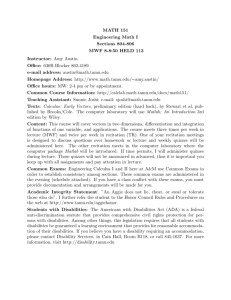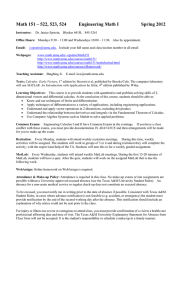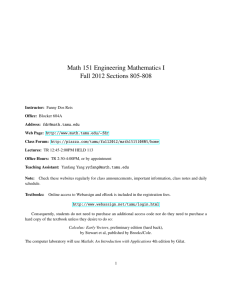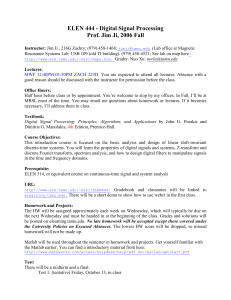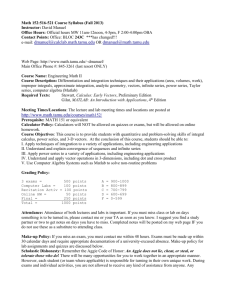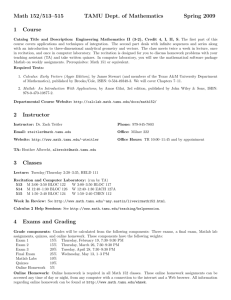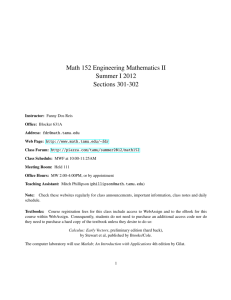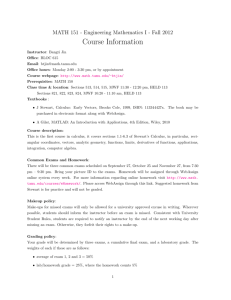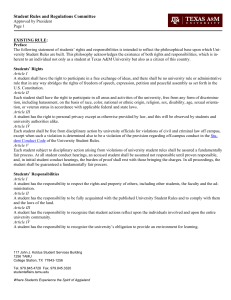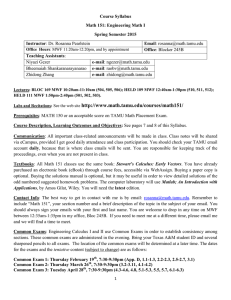MATH 151 Engineering Math I Sections 813-815 TR 11:10
advertisement
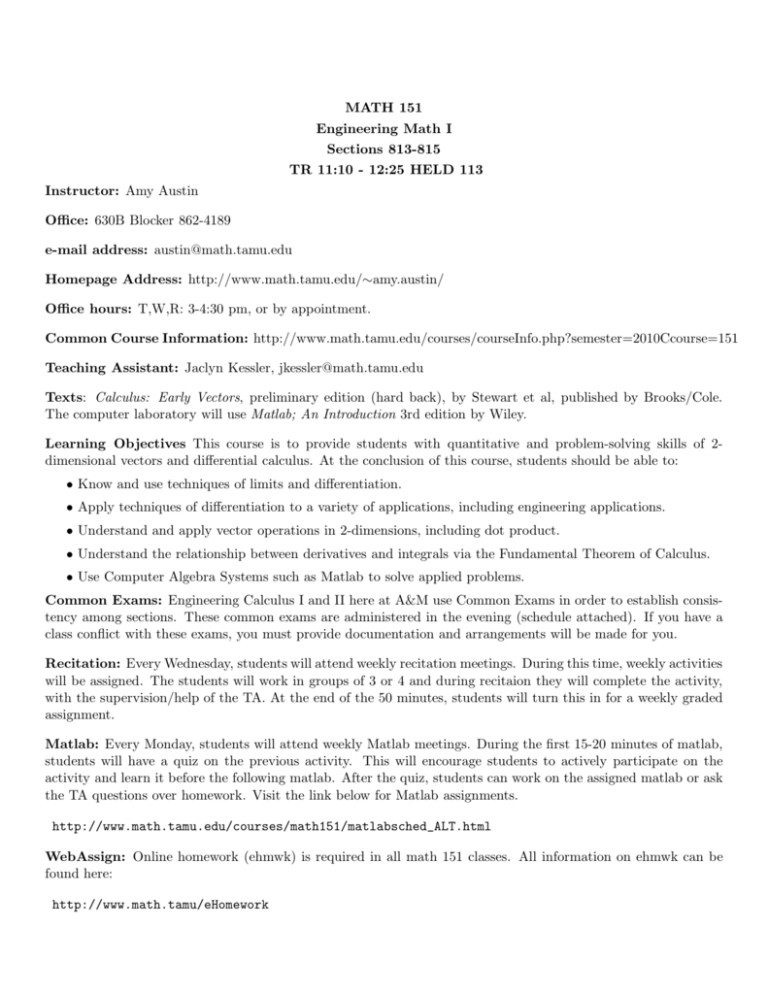
MATH 151 Engineering Math I Sections 813-815 TR 11:10 - 12:25 HELD 113 Instructor: Amy Austin Office: 630B Blocker 862-4189 e-mail address: austin@math.tamu.edu Homepage Address: http://www.math.tamu.edu/∼amy.austin/ Office hours: T,W,R: 3-4:30 pm, or by appointment. Common Course Information: http://www.math.tamu.edu/courses/courseInfo.php?semester=2010Ccourse=151 Teaching Assistant: Jaclyn Kessler, jkessler@math.tamu.edu Texts: Calculus: Early Vectors, preliminary edition (hard back), by Stewart et al, published by Brooks/Cole. The computer laboratory will use Matlab; An Introduction 3rd edition by Wiley. Learning Objectives This course is to provide students with quantitative and problem-solving skills of 2dimensional vectors and differential calculus. At the conclusion of this course, students should be able to: • Know and use techniques of limits and differentiation. • Apply techniques of differentiation to a variety of applications, including engineering applications. • Understand and apply vector operations in 2-dimensions, including dot product. • Understand the relationship between derivatives and integrals via the Fundamental Theorem of Calculus. • Use Computer Algebra Systems such as Matlab to solve applied problems. Common Exams: Engineering Calculus I and II here at A&M use Common Exams in order to establish consistency among sections. These common exams are administered in the evening (schedule attached). If you have a class conflict with these exams, you must provide documentation and arrangements will be made for you. Recitation: Every Wednesday, students will attend weekly recitation meetings. During this time, weekly activities will be assigned. The students will work in groups of 3 or 4 and during recitaion they will complete the activity, with the supervision/help of the TA. At the end of the 50 minutes, students will turn this in for a weekly graded assignment. Matlab: Every Monday, students will attend weekly Matlab meetings. During the first 15-20 minutes of matlab, students will have a quiz on the previous activity. This will encourage students to actively participate on the activity and learn it before the following matlab. After the quiz, students can work on the assigned matlab or ask the TA questions over homework. Visit the link below for Matlab assignments. http://www.math.tamu.edu/courses/math151/matlabsched_ALT.html WebAssign: Online homework (ehmwk) is required in all math 151 classes. All information on ehmwk can be found here: http://www.math.tamu/eHomework Academic Integrity Statement: “An Aggie does not lie, cheat, or steal or tolerate those who do”. I further refer the student to the Honor Council Rules and Procedures on the web at http://www.tamu.edu/aggiehonor Students with Disabilities: The Americans with Disabilities Act (ADA) is a federal anti-discrimination statute that provides comprehensive civil rights protection for persons with disabilities. Among other things, this legislation requires that all students with disabilities be guaranteed a learning environment that provides for reasonable accommodation of their disabilities. If you believe you have a disability requiring an accommodation, please contact Disability Services, in Cain Hall, Room B118, or call 845-1637. For more information, visit http://disability.tamu.edu Grades: Your grade will be determined by 3 exams, a comprehensive final, and the lab grade/Online Homework as follows: Exam I: ( 16 of course grade) R, Sept 30, 7:30-9:30 pm Exam II: ( 16 of course grade) R, Oct 28, 7:30-9:30 pm Exam III: ( 16 of course grade) T, Nov 30, 7:30-9:30 pm Final Exam: ( 41 of course grade) F, Dec 10, 3-5 pm 1 Activities: ( 20 of course grade) 3 of course grade) Matlab: ( 40 3 Quizzes: ( 40 of course grade) 1 WebAssign (ehmwk): ( 20 of course grade) Make-up policy: No make-ups will be given without written evidence of an official University excused absence. (See University Student Rules.) According to Section 7.3 of the University Student Rules, for an absence to be considered excused, ‘the student must notify his or her instructor in writing (acknowledged e-mail message is acceptable) prior to the date of absence if such notification is feasible. In cases where advance notification is not feasible, the student must provide notification by the end of the second working day after the absence. This notification should include an explanation of why notice could not be sent prior to the class. “If no such notice is given, the rights to a make-up are forfeited. In addition (and also in accordance with University Student Rules), a written excuse must be presented upon return to class. Specifically, in the case of illness or injury, students are required to obtain a confirmation note from a health care professional affirming date and time of a medical office visit regarding the illness or injury and confirming the need of absence before a make-up will be given. Sources of help: Use it! 1. Office Hours: My office hours will be Tuesday/Wednesday/Thursday afternoon, 3-4:30 pm. If you cannot attend my office hours, send me an e-mail with your available times and we will schedule an appointment. 2. Week in Review: Each week, a Week in Review will be conducted by a faculty member. The dates and times will be announced in class and will be linked on my webpage. 3. Help Sessions: The Math department offers help sessions for math 151. The dates and times will be announced in class and will be linked on my webpage. 4. Streaming videos: http://www.math.tamu.edu/∼amy.austin/wirmath151.html Weekly Schedule: • Week 1 ◦ Appendix D, Section 1.1 Introduction, trigonometry review, two-dimensional vectors • Week 2 ◦ Sections 1.2, 1.3, 2.2 Dot product, parameterized curves, (qualitative) definition of limit • Week 3 ◦ Sections 2.3, 2.5, 2.6 Calculation of limits, limits at infinity, continuity. • Week 4 ◦ Sections 2.7, 3.1, 3.2 Velocity, differentiation • Week 5 ◦ Sections 3.3, 3.4 Rates of Change. Derivatives of the trigonometric functions, and Exam I (Thursday, covering thru Section 3.2) • Week 6 ◦ Sections 3.5, 3.6, 3.7 Chain rule, implicit differentiation, derivatives of vector-valued functions • Week 7 ◦ Sections 3.8, 3.9, 3.10 Higher derivatives, tangents of parameterized curves. Related rates • Week 8 ◦ Sections 3.11, 4.1, 4.2 Differentials and approximation, exponential and inverse functions. • Week 9 ◦ Sections 4.3, 4.4 Logarithmic functions, derivatives of logarithms, and Exam II (Thursday, covering Sections 3.3-4.2) • Week 10 ◦ Sections 4.5, 4.6, 4.8 Exponential growth and decay, inverse trigonometric functions, L’Hospital’s Rule • Week 11 ◦ Sections 5.1, 5.2,5.3 Graphical interpretation of the derivative, first and second derivative tests • Week 12 ◦ Sections 5.5, 5.7, 6.1 Applied max/min, antiderivatives, Riemann sums • Week 13 ◦ Sections 6.2, 6.3 Area and the definite integral. Thanksgiving falls this week. • Week 14 ◦ Section 6.4 The Fundamental Theorem of Calculus and Exam III (Tuesday, covering Sections 4.3-6.3) • Week 15 ◦ Review for FINAL. Last day of class is Tuesday. Note that the last week of class has redefined day(s). See Important Dates for details. Suggested Homework: • Appendix D: 1, 4, 9, 19, 23, 25, 27, 29, 33, 46, 55, 63, 67, 69, 77 • Section 1.1: 3, 5, 9, 13, 17, 19, 21, 25, 27, 29 • Section 1.2: 1, 5, 7, 13, 15, 17, 21, 25, 31, 35, 37, 41, 43, 51, 53, 55 • Section 1.3: 1, 3, 7, 11, 15, 19, 25, 27, 29, 31, 34 • Section 2.1: 1, 3, 5, 11 • Section 2.2: 3, 5, 7, 13, 17, 21 • Section 2.3: 3, 5, 6, 7, 13, 19, 23, 27, 39, 41, 45, 55, 67, 71 • Section 2.5: 1, 3, 9, 15, 17, 23, 29, 33, 37, 39, 43, 47 • Section 2.6: 3, 11, 17, 27, 29, 35, 45, 47 • Section 2.7: 1, 3, 5, 9, 11, 15, 17, 21, 23 • Section 3.1: 1, 5, 7, 13, 15, 23, 33, 34, 37, 39, 41, 47, 51, 53 • Section 3.2: 3, 7, 9, 15, 19, 23, 29, 37, 39, 43, 50, 53, 55, 61, 70, 72 • Section 3.3: 3, 7, 9, 11, 13, 17, 23 • Section 3.4: 5, 7, 11, 15, 19, 21, 23, 27, 31, 33, 45 • Section 3.5: 3, 7, 11, 13, 27, 33, 49, 51, 57, 59, 79, 80 • Section 3.6: 1, 5, 11, 13, 21, 25, 27, 33, 35, 39, 45 • Section 3.7: 3, 5, 11, 13, 17, 21 • Section 3.8: 1, 2, 5, 11, 17, 31, 35, 43, 46, 49, 51 • Section 3.9: 3, 5, 7, 9, 13, 17, 21 • Section 3.10: 5, 7, 9, 11, 15, 17, 19, 23, 27, 31, 33 • Section 3.11: 3, 9, 10, 14, 23, 27, 35, 36, 38, 39, 41, 45 • Section 4.1: 3, 6, 7, 10, 17, 21, 25, 27, 29, 31, 35, 43, 47, 49, 59 • Section 4.2: 3, 5, 7, 11, 13, 15, 19, 23, 25, 31, 35 • Section 4.3: 3, 7, 11, 19, 21, 25, 29, 39, 43, 45, 51, 61, 70, 73, 79, 87 • Section 4.4: 3, 7, 9, 13, 19, 27, 35, 39, 51, 59 • Section 4.5: 3, 5a), 9, 11, 13, 15, 19, 21 • Section 4.6: 3, 9, 17, 23, 27, 31, 35, 45, 51, 53, 65, 66 • Section 4.8: 3, 9, 13, 17, 19, 25, 39, 41, 47, 55, 57, 61, 65 • Section 5.1: 1, 3, 5, 11, 13, 17, 19, 21 • Section 5.2: 3, 7, 11, 17, 19, 25, 27, 31, 37, 39, 41, 43, 45 • Section 5.3: 1, 5, 7, 9, 13, 17, 19, 21, 35, 43, 45 • Section 5.5: 1, 5, 7, 9, 13, 17, 19, 23, 27, 29, 31, 33, 39 • Section 5.7: 3, 7, 9, 15, 17, 21, 23, 27, 31, 37, 39, 41, 43, 45, 49, 59, 61, 65, 71, 73, 79 • Section 6.1: 5, 9, 19, 25, 41b), 43 • Section 6.2: 1, 5, 13, 15 (at least be able to set up the the Riemann sum for 13 and 15), 23 • Section 6.3: 7, 11, 17, 33, 35, 45, 47, 53, 55 • Section 6.4: 1, 3, 7, 9, 11, 19, 23, 27, 31, 41, 47, 51, 57, 73, 77, 79, 83, 93, 95
